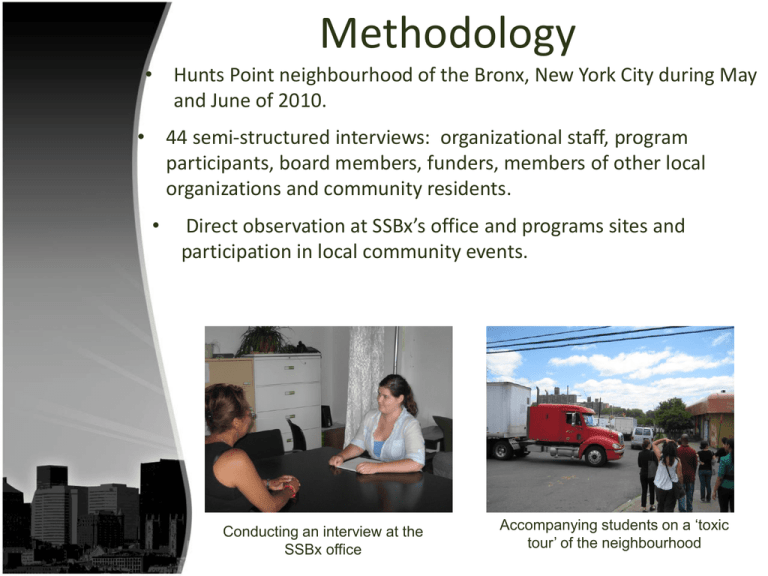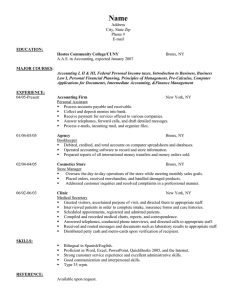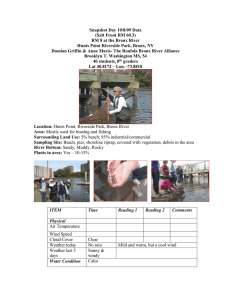Methodology
advertisement

Methodology • Hunts Point neighbourhood of the Bronx, New York City during May and June of 2010. • 44 semi-structured interviews: organizational staff, program participants, board members, funders, members of other local organizations and community residents. • Direct observation at SSBx’s office and programs sites and participation in local community events. Conducting an interview at the SSBx office Accompanying students on a ‘toxic tour’ of the neighbourhood Ensuring Sustainable Neighbourhood Growth: Lessons from New York City’s South Bronx Kara Quennell Research Question: How can environmentally based programs and policy initiatives be used address environmental, political and economic inequality? Environmental Health and Equity: Global Strategies and Innovation April 30, 2011 McGill University Intersection at entrance to Hunts Point Riverside Park Inside Hunts Point Riverside Park Organizational Challenges In 2001, at its inception, SSBx was: • A small organization • Guided and propelled by founder’s vision. • Had an antagonistic relationship with local government • Had tense relationships with other local groups stemming from issues around sharing and taking credit. 10 years later, SSBx has: • Greatly expanded their staff and programming. • Established themselves as an important and legitimate voice in activist and political circles. Furthermore, the political climate has evolved to acknowledge the disorderly development of Hunts Point and the South Bronx. Challenges in adapting to this growth and changing political context: •Maintaining consistent mechanisms of soliciting community direction and feedback. •Developing collaborative (rather than antagonistic) relationships with local government and other local groups. •Adapting their vision and communication mechanisms to ensure that the overall organizational goal, as well as how each program fits within it, is clear to staff, funders and the community. Hunts Point and the South Bronx Poverty and crime: Located in the nation’s poorest congressional district, historically known as neighbourhoods characterised by poverty and crime as well as the co-location of residential and industrial development. Unemployment: Despite the presence of industry, community members consider unemployment to be one of the neighbourhoods’ biggest issues. Adverse health impacts: Approximately 60 000 trucks carry goods in and out of Hunts Point’s industrial sector each week. This, along with emissions from industrial processes, have lead to persistent air quality and odour issues including high rates of asthma. Lack of political capital: A lack of community pride and political engagement is paired with a sense, on the part of residents, that they have been disenfranchised and ignored by their government. SUSTAINABLE SOUTH BRONX (SSBx) ECONOMY SOCIAL ENVIRONMENT “Sustainable South Bronx (SSBx) works with the South Bronx and other underserved urban communities as they transform themselves into great sustainable places to live. We do this by providing a collaborative model that addresses environmental, economic and social concerns through policy change, green job training, environmental education, and community greening programs.” Sustainable South Bronx Mission Statement Sustainable South Bronx was founded in 2001 by Majora Carter. GOALS 1. Create solutions from a standpoint that sees communities as embedded in their environments 2. Find ways to work with industry to promote a healthy environment and provide economic opportunities for local residents 3. Create accessible and inviting community Greenspace PROGRAMS and INITIATIVES *Greenjob training *Neighbourhood greening initiatives *Policy advocacy *A green innovation laboratory and education program *Active living promotion through community events (ie. Hunts Point Hustle and biannual block parties) Lessons Learned • Convergence of economic, political and environmental inequality: Programs and initiatives to address those issues must take all the above aspects into account. • SSBx strongest programs and initiatives are those – with clearly articulated goals – that are supported by partnerships with other organizations and local government – that pragmatically assess and work with the existing situation • Intensity of programs: The BEST Greenjob training’s unique success is related to the length, commitment required and focus on individual development. • Ongoing assessment: As organizations grow and political contexts change, organizations must re-evaluate their programs, goals and modes of operation. The many issues faced by these neighbourhoods exemplify the convergence of political, economic and environmental inequality. “there is a pattern of co-location of unhealthy land uses and low-income or resource poor communities on a national and a global scale and the issues that we see in Hunt’s Point are issues that you see in low-income communities of colour everywhere” - SSBx Staff member BEST Greenjob training • First job training program: BEST ECO, in 2003 in response to community concerns and high unemployment. • The program lasts 17-19 weeks and targets those who have experienced barriers to employment. Training includes: – Practical skills for building and maintaining Green infrastructure – Hazmat, OSHA and other certifications – Life skills such as time management, budgeting, professional conduct and conflict management – Mock interviews, physical fitness and team building exercises • Post-training, SSBx job developers help participants to find employment and then follow participants for ~3 years. • In 2009, SSBx expanded BEST to include BEST 4 Buildings, which teaches the practical skills needed for Green construction. • In 2010, SSBx was running 3 cycles of each training program per year, each with about 20 participants, training about 120 per year. BEST Success: Investing in Individuals • • High success rates: job placement (~80%) and retention (about 2/3rds stay in their first job). BEST participants: Former welfare recipients (2/3rd) and history of incarceration (1/3rd) • Why is the BEST Greenjob training program successful? – – – – – Clear, tangible and easily articulated goals to direct staff activities and programming decisions. Pragmatic understanding of the contexts in which their participants will be seeking employment. Program tailored to provide specifically tailored skills: technical abilities and certifications. Intensity of program: Participation 5 days a week, from 8-4, consistently for over 3 months. Individual development: Teaching participants self-assessment tools, problem-solving skills and conflict management. – Strong and talented staff: many of whom have completed the program themselves and thus serve as a positive example to current participants. – Job developers who actively make connections, look for opportunities for participants and follow participants for at least 3 years providing support and mediating potential conflicts. ACKNOWLEDGMENTS: SSBx, IHSP, community members in the South Bronx and Hunts Point, members of other organizations in NYC, family and friends who supported me. Thank you! The Bronx River from Hunts Point Riverside Park Greenspace: Fostering neighbourhood empowerment and health SSBx’s neighbourhood greening initiatives have multiple benefits: 1) Environmental – Improving air quality and mitigating the effects of storm water 2) Economic – Providing Green maintenance jobs for BEST graduates 3) Health – Providing cleaner air and accessible and safe spaces for being active out of doors 4) Political – Taking back public space, redressing historical privileging of industrial development over that of Greenspace, and providing an example of positive tangible change “It will benefit people, realizing the treasures in their own neighbourhood. And it is a reflection of your self-worth and we’re looking to change people’s perspective not only from outside of the neighbourhood but from within the neighbourhood to see all of these great things, to remind them that it’s there.” Executive Director of The Point CDC (An organization with whom SSBx partners) Policy advocacy • Collaborations and Advocacy SSBX works with other local groups and with the city in the development of the Greenway and participates in many local, statewide and national coalitions that advocate for policy change. • Ensuring community voices are heard SSBX ensure that local perspectives and concerns remain at the forefront of the design and implementation of new infrastructure and that development goals are maintained regardless of changing administrations and political priorities. • Mediator Role In their coalition work, SSBx acts as a mediator between the interests of large environmental organizations, local community groups and government bodies.


